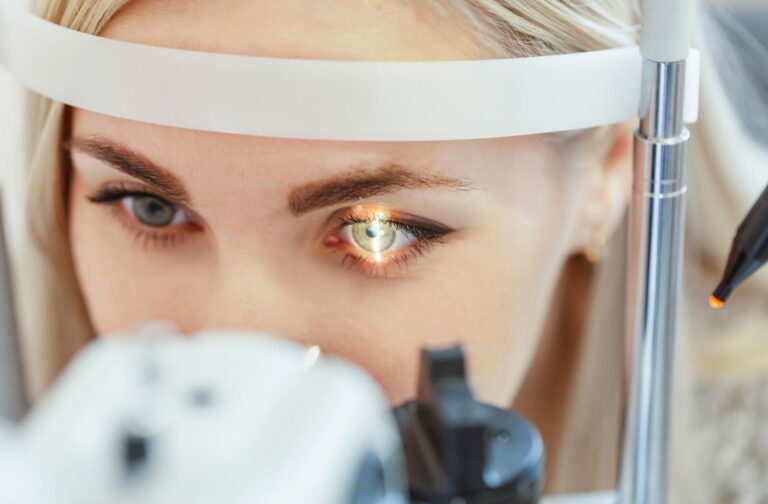What Happens During a Comprehensive Eye Exam?
Regular eye exams are essential for maintaining good eye health and overall well-being. Understanding what happens during a comprehensive eye exam can help you feel prepared and informed.
During a comprehensive eye exam, your optometrist will guide you through a series of tests to measure both the acuity of your vision and your overall eye health, especially signs that you’re at risk of eye disease. This includes not only the standard “vision tests” that everyone imagines (like looking at an eye chart), but also examinations of the structures of your eye and the muscles in your eye area.
How Long Does a Comprehensive Eye Exam Take?
If your eyes are generally healthy, a comprehensive eye exam will normally take 30 to 45 minutes. However, if your optometrist discovers something unusual or you have a condition that makes eye exams more difficult, the process may take longer.
What Happens During a Comprehensive Eye Exam
Here’s a list of steps your optometrist might take during your comprehensive eye exam.
Initial Consultation and Medical History
Your comprehensive eye exam will begin with an initial consultation where the optometrist or a trained assistant will ask about your medical history. This includes:
- Previous eye conditions or surgeries
- Family history of eye diseases
- Current medications
- Any visual problems you might be experiencing, such as blurred vision or eye strain
This information helps the eye care professional tailor the exam to your specific needs and identify any potential risk factors.
Preliminary Tests
Before the main examination, preliminary tests are conducted to gather baseline information about your eyes and vision. These tests might include:
- Visual Acuity Test: Using an eye chart to measure how well you can see at various distances.
- Colour Vision Test: Checking for color blindness or deficiencies.
- Depth Perception Test: Assessing your ability to judge distances between objects.
- Autorefractor Test: Providing an initial prescription for eyeglasses or contact lenses by measuring how light is changed as it enters your eye.
Refraction Assessment

The refraction assessment determines your exact eyeglass prescription. During this test, you’ll look through a device called a phoropter and respond to questions about which lens options provide the clearest vision. This step helps determine if you are nearsighted, farsighted, or have astigmatism.
Eye Health Evaluation
A comprehensive eye exam also includes a detailed assessment of your eye health, which involves several key tests:
- Slit Lamp Examination: Using a microscope called a slit lamp, the optometrist examines the structures of your eye, such as the cornea, iris, lens, and retina. This test can detect conditions like cataracts, macular degeneration, and corneal ulcers.
- Tonometry: Measuring the pressure inside your eyes to screen for glaucoma. A small puff of air or a special probe is used to measure intraocular pressure.
- Retinal Examination: Also known as ophthalmoscopy or fundoscopy, this test allows the eye doctor to see the back of your eye, including the retina, optic disc, and underlying blood vessels. Dilation drops may be applied to widen your pupils for a clearer view.
Additional Tests (If Necessary)
Depending on your age, medical history, and specific concerns, additional tests may be performed:
- Visual Field Test: Assessing your peripheral (side) vision to detect blind spots or other visual field defects.
- Optical Coherence Tomography (OCT): Capturing detailed cross-sectional images of the retina to diagnose and monitor conditions like macular degeneration and diabetic retinopathy.
- Corneal Topography: Mapping the surface curvature of the cornea, which is particularly useful for contact lens fittings and detecting corneal diseases.
Discussion and Recommendations
After completing the various tests and assessments, the optometrist will discuss the results with you. This includes:
- Explaining any findings or diagnoses
- Recommending treatments, eyewear, or lifestyle changes
- Answering any questions or concerns you may have
How Often Should I Have an Eye Exam?
The Canadian Association of Optometrists gives the following guidelines for eye exams:
- Children should have their first comprehensive eye exam between six and nine months old, their second between two and five years old, a third before starting school, and another each year afterward.
- Adults should normally have comprehensive eye exams every two years.
- Seniors should have comprehensive eye exams every year.
- Anyone with diabetes should have eye exams every year.
Ready For Your Eye Exam?
A comprehensive eye exam is more than just a vision test; it’s a thorough evaluation of your eye health that can detect early signs of diseases and ensure you maintain optimal vision. Regular exams are crucial for adults, as they help prevent potential issues and keep your eyes in excellent condition.Ready to schedule your comprehensive eye exam? Contact us today and take the first step toward better eye health with MB Optometry!

